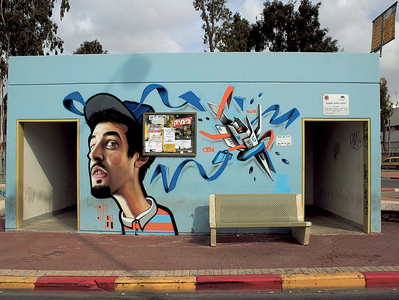Experiential Exhibition: The Simulated Bomb Shelter
Posted: March 27, 2012 Filed under: Event, Museum News | Tags: Artists 4 Israel, Columbia University, experiential exhibition, Israeli Bomb Shelter Museum, Paul Virilio, Simulation, War and Cinema Leave a commentAccording to metro,the pro-Israel graffiti group Artists 4 Israel was recently turned away from Columbia University where it intended to bring a controversial Israeli Bomb Shelter Museum. The “museum,” housed in a replica bunker similar to those found in Southern Israel, simulates the experience of a rocket attack through the use of sound and video. The group set up the museum last year in Washington Square Park but the loud noise quickly drew police attention and it was closed down after just half an hour.
The Artists 4 Israel website has recently been hacked but Israeli National News quotes a description of the project:
“The bomb shelter is a Museum of Living History and Art Installation. A functional bomb shelter built in the exact specifications of those found in Sderot, Israel, on the border of Gaza, this refuge mimics the feel, look, small and sounds of the original. From wailing ‘Red Alert’ sirens to interactive computer terminals, a multi-media presentation provides facts and education about the conflict in the Middle East while artistic flourishes create emotive and important and visceral reactions in the visitor.”
The description of this proposed exhibition made me feel a little squeamish. Not only because of the sometimes anti-Palestinian vibe of the artists but because the projects reminded me of something Paul Virilio wrote about in his startling book War and Cinema:
“After 1945, this cinematic artifice of the war machine spread once more into new forms of spectacle. War museums opened all over liberated France at the sites of various landings and battles, many of them in old forts or bunkers. The first rooms usually exhibited relics of the last military-industrial conflict (outdated equipment, old uniforms and medals, yellowing photographs), while others had collections of military documents or screenings of period newsreels. It was not long, however, before the invariably large number of visitors were shown into huge, windowless rooms resembling a planetarium or a flight (or driving) simulator. In these war simulators, the public was supposed to feel like spectators-survivors of the recent battlefield.
…
If one thinks of the cinema-mausoleums or atmospheric cinemas of the thirties, one can see in this a new outflanking of immediate reality by the cinematic paramnesia of the war machine.
…
The sites chosen for museums of the Second World War remind us that these fortress-tombs, dungeons and bunkers are first and foremost camerae obscurae, that their hollowed windows, narrow apertures and loopholes are designed to light up the outside while leaving the inside in semi-darkness.”
(pg 48-49)
Art often appeals to the emotions of the viewer but there is always a risk when mixing reality (such as the complexities of the Israeli-Palestinian conflict) with fantasy.
On the other hand, aren’t all museums places of fantasy to some degree? They’re constructed environments, representations of the past or emissaries from an idealized present/future. The difficulty is creating some kind of truth through the narratives told and the objects/experiences used to tell them, the transformation of a kind of fiction into reality. But according to Virilio, it goes both ways; if I found myself in an actual war zone, I’d likely feel that I was in a movie. Fictionalizing reality through simulation can provide access to events but does it also train us to experience the world as no more than representation?
